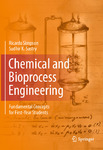| dc.description.abstract | No introductory chemical engineering book covers all the branches related to
chemical engineering in the twenty-first century. In addition, existing books,
independent of content, generally cover only chemical engineering or biochemical
engineering, but not both chemical and bioprocess engineering.
Bioprocess engineering is broader than biochemical engineering, covering
other areas such as food engineering, environmental engineering, biochemical
processing, and biological engineering.
Many books offer broad-based introductions to the subject but do not
reveal the underpinnings of future knowledge. One key motivation in our
case is the approach of Robert H. Frank (http://www.robert-h-frank.com/),
wherein the building of understanding of the fundamentals via practice with
relevant real-world examples takes precedence over the coverage of large
amounts of material. Herein, we identify specific areas within which specific
levels of competencies are to be attained. To facilitate and orient professors
and students, we will classify each chapter following Bloom’s taxonomy
(BT). Each chapter will be identified in relation to the cognitive domains of
BT: (1) knowledge, (2) comprehension, (3) application, (4) analysis and
synthesis, (5) evaluation, and (6) creation.
Our approach involves a thorough grounding in the fundamentals so that
the background may be used in future work. Here we present numerous
solved and proposed exercises (more than 400). In each chapter, problems
will be classified by level of difficulty (from 1 to 10+, were 10+ is the most
difficult). Each chapter will have references and selected Web pages to
vividly illustrate all the examples. Since this is intended to be an introductory
book, some concepts will receive closer attention than others. Therefore, as
mentioned, each chapter will be clearly marked according to BT. A note to
students using this book: we are not pretending that you will be an expert in everything, but you will be fully prepared as a problem solver and with
probably the most important knowledge of a future chemical and bioprocess
engineer, which is to say you will receive a rigorous preparation in material
balances. As stated, you will not learn a large quantity of material, but you
will be armed with the necessary tools for success. Just follow our
recommendations firmly and consistently. As we repeatedly tell our students,
you need to be dutiful.
Motivation is a key aspect and component in your first steps as an
engineer. There is a need to engage students with interesting material,
especially in a subject matter like units and dimensions, which are critically
important but somewhat dry. Thus, many of the examples involve real-world
situations to which students may be able to relate readily. In this book, you
will be exposed to all of the chemical and bioprocess engineering areas, so
you will understand your future role in society, and, most importantly, we
will do our best to communicate to you the enchantment we feel with this
marvelous profession. | en_US |

